Crates are extremely useful tools for owning, training, and caring for a dog. We understand that your initial association with crate training may be punishment – or something a dog would naturally dislike. On the contrary, it is quite natural for dogs to want a small, cozy area to themselves to relax and practice their denning instinct.
Why should you try Crate Training?
Everyone, both human and non, wants a space of their own. We have bedrooms that we can retreat to when we want to get away from others; unless provided, dogs don’t have this space as much. A crate serves as your dog’s own private haven that they can go to when they need time for themselves. Crates are also helpful when it comes to other aspects of training–for instance, dogs do not want to make their “den” dirty by going to the bathroom. When your pup loves their crate, they will make an effort not to go potty in it. In this way, you can gradually train them to hold their bladder for an adequate period of time before you let them out. You can also use the crate as a place for them to go to when guests come over so that they do not jump up and overwhelm them. The process of training your pup to like their crate can be long, but it is rewarding and offers both of you greater peace of mind.
The Initial Introduction
First impressions have a significant impact when it comes to any kind of training. The goal is to create positive associations with the crate, so do not force your dog into it. Leave the door open with tempting items inside (a bed, blanket, toys, water bowl, etc.) and allow your dog to enter and explore it as they like over the next few days. Be sure to put the crate in the spot you intend to keep it long-term so that your dog grows used to the area. It may be helpful to keep it in a place where your family spends a lot of time, like a living or dining room. Any time you see them willingly enter the crate, mark it with a “yes!” or a click if you have a clicker nearby, and say your command word (“crate,” “kennel,” “bed,” etc.). Reward them with a treat as well, and crate training becomes a lot easier.
Food is a great motivator
On top of giving them treats when they go into their crate on their own, you should feed them meals there as well. Most dogs love food, and by association, they get excited about the areas where they get fed. Giving your dog dinner in their crate builds a positive association between the crate and happy feelings. To start training them to accept the door closed, shut it softly during one of their meals after having a few days to get used to eating there. Keep it closed for just 10-20 seconds before opening it again. At the next meal, keep it closed a little longer. Over time, you should gradually increase the amount of time the door gets closed. Once they can stay in the crate for their whole meal, you can try giving them food, shutting their crate, then leaving the house for a few minutes. Eventually, you will be able to leave them crated when you leave the house so that they stay out of trouble but are happy in their cozy den.
Crate training is just one of the many behaviors you can teach your dog that will make your life less chaotic and their life more secure. If you need more advice or help with these behaviors, call Gulf Coast K9 Dog Training in Bradenton.





